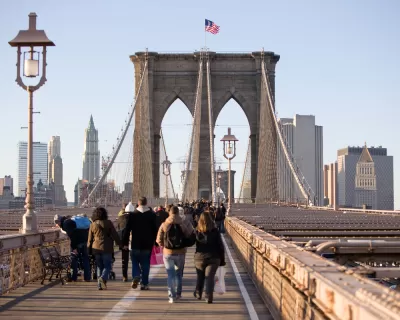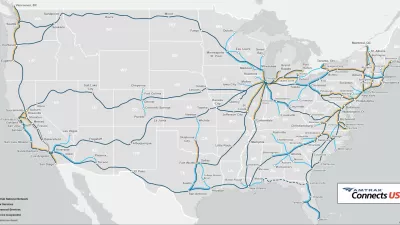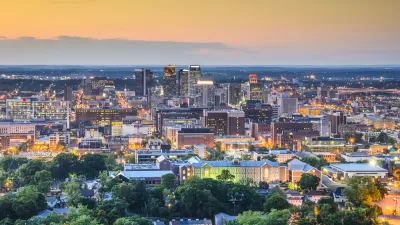After a week of speculation and rumor, the Biden administration today revealed its promised infrastructure plan.

The Biden administration revealed the "American Jobs Plan" earlier today, posting the plan on WhiteHouse.gov and holding a press briefing to reveal details of the plan.
The plan is smaller in cost than had been previously reported (coming in closer to $2 trillion than the $3 trillion and even $4 trillion reported earlier), but at first glance, the spending package marks a significant departure from the federal government's traditional approach to infrastructure, especially on proposed spending related to transportation priorities and climate change but also by adding issues like housing and care facilities into the discussion about infrastructure.
As evidence of the broad scope of the plan, the fact sheet posted on WhiteHouse.gov lists the following as primary goals:
- Fix highways, rebuild bridges, upgrade ports, airports and transit systems.
- Deliver clean drinking water, a renewed electric grid, and high-speed broadband to all Americans.
- Build, preserve, and retrofit more than two million homes and commercial buildings, modernize our nation’s schools and child care facilities, and upgrade veterans’ hospitals and federal buildings.
- Solidify the infrastructure of our care economy by creating jobs and raising wages and benefits for essential home care workers.
- Revitalize manufacturing, secure U.S. supply chains, invest in R&D, and train Americans for the jobs of the future.
- Create good-quality jobs that pay prevailing wages in safe and healthy workplaces while ensuring workers have a free and fair choice to organize, join a union, and bargain collectively with their employers.
The plan would spend $2 trillion to rebuild 20,000 miles of roads and repair 10,000 bridges, according to the count of Jim Tankersley, who was among the first to report the details of the new plan. Tankersley also notes a key innovation in this plan compared to spending plans implemented by the Obama administration after the Great Recession:
The spending in the plan would take place over eight years, officials said. Unlike the economic stimulus passed under President Barack Obama in 2009, when Mr. Biden was vice president, officials will not in every case prioritize so-called shovel ready projects that could quickly bolster growth.
Another article by Ella Nielsen explains more about the thinking behind the long-term approach of the American Jobs Act: "Biden plans to argue that revitalizing American infrastructure will create millions of well-paying jobs, lower the country’s carbon emissions, and help the US compete on the world stage, especially with China."
Getting down to brass tacks, Nielsen also offers more details on how the spending package breaks own by sector:
The plan includes $621 billion in infrastructure spending dedicated to rebuilding the nation’s roads, bridges, ports, and rail systems. It also contains $300 billion to bolster manufacturing, $213 billion for affordable housing, and a collective $380 billion for research and development, modernizing America’s electricity grid, and installing high-speed broadband around the country. The plan also includes $400 billion for home- and community-based health and elder care.
President Biden is expected to give a speech outlining more on the plan in Pittsburgh later today. Meanwhile, planning Twitter is already parsing the numbers and searching for insight. Angie Schmitt live tweeted the press conference earlier today, sprinkling in some commentary along the way.
I'm on a special press briefing on the "American Jobs Plan" (The infrastructure plan) with White House Officials. I'm gonna live Tweet it in a thread now.
— Angie Schmit (@schmangee) March 31, 2021
Yonah Freemark has also tweeted insight useful to an initial understanding of the plan.
Biden infrastructure package would be a very big federal investment in the surface transport system:
-$115b fix-it-1st roads
-$85b transit
-$80b intercity rail
-$174b for electric vehiclesTop line: The package takes climate change seriously & funds transit over road expansion.
— Yonah Freemark (@yfreemark) March 31, 2021
White House Spokesperson Katherine Bedingfield this morning highlighted the $85 billion in the plan for transit as a major increase in spending for public transit (the final amount for transit included in the American Rescue Plan, approved earlier this year, was $30 billion). Transit agencies are still struggling to find their financial footing after ridership has evaporated—with fare revenues evaporating along with riders.
The plan's stated intention to fix auto-oriented transportation infrastructure rather than launch a major new road building program (i.e., the "fix it first" approach supported recently in statements by U.S. Department of Transportation Secretary Pete Buttigieg) is another significant from previous infrastructure planning efforts, seemingly providing a positive response to the work of advocates to leverage this plan to move the country away from the auto-oriented status quo. Freemark notes that the American Jobs Plan does not include whatever transportation spending is approved when Congress reauthorizes the five-year federal surface transportation bill—work on that bill is already underway. "That legislation, which is expected to be renewed this fall, is funded by other sources and would likely add $60b/year, or $300b/5 years, for surface transport," according to Freemawk on Twitter.
Another article by Scott Detroit and Tamara Keith provides additional details on how the American Jobs Plan would tackle climate change (beyond slowing the federal government's ongoing investment in auto-oriented transportation infrastructure). "Embedded within the plan are efforts to build out U.S. clean energy infrastructure that, by itself, would rank as one of the most ambitious initiatives ever by the federal government to lower the country's greenhouse gas emissions," according to the article. One of the proposals in the plan that would help achieve an ambitious climate change agenda is a "New Deal-inspired Climate Conservation Corps to work on conservation projects and environmental justice efforts..."
The package includes $74 billion for the advancement of electric vehicle infrastructure, although the effect of electric vehicles on greenhouse gas emissions is very much still up for debate. "Biden wants to spend billions on rebates and tax incentives to encourage Americans to purchase electric vehicles, and he proposes paying for the transition of thousands of transit and school buses from diesel to electric. At the same time, he wants incentives for state and local governments to build electric vehicle charging stations to power those new cars and buses," write Detroit and Keith.
All of the articles cited here devote attention to the matter of how to pay for the American Jobs Plan, a point which is likely to create friction for the plan as it moves through Congress. Here's how Nielsen explains the funding component of the plan—itself a series of major policy changes:
The White House estimates the infrastructure plan will be paid for within the next 15 years, if Biden’s newly proposed “Made in America” tax plan is also passed. That tax plan would raise the corporate tax rate to 28 percent to pay for infrastructure and close a number of loopholes to prevent corporations from stashing their money in offshore banks to evade taxes. It does not, however, raise the capital gains tax — an idea Biden initially floated during his presidential campaign.
Nielsen's conclusion based on the substance and scope of the plan: the Biden administration is fundamentally rethinking the role of the federal government. If approved by Congress and adopted as law in all its various manifestations, that assessment of the American Jobs Act is likely to be true.

Maui's Vacation Rental Debate Turns Ugly
Verbal attacks, misinformation campaigns and fistfights plague a high-stakes debate to convert thousands of vacation rentals into long-term housing.

Planetizen Federal Action Tracker
A weekly monitor of how Trump’s orders and actions are impacting planners and planning in America.

San Francisco Suspends Traffic Calming Amidst Record Deaths
Citing “a challenging fiscal landscape,” the city will cease the program on the heels of 42 traffic deaths, including 24 pedestrians.

Defunct Pittsburgh Power Plant to Become Residential Tower
A decommissioned steam heat plant will be redeveloped into almost 100 affordable housing units.

Trump Prompts Restructuring of Transportation Research Board in “Unprecedented Overreach”
The TRB has eliminated more than half of its committees including those focused on climate, equity, and cities.

Amtrak Rolls Out New Orleans to Alabama “Mardi Gras” Train
The new service will operate morning and evening departures between Mobile and New Orleans.
Urban Design for Planners 1: Software Tools
This six-course series explores essential urban design concepts using open source software and equips planners with the tools they need to participate fully in the urban design process.
Planning for Universal Design
Learn the tools for implementing Universal Design in planning regulations.
Heyer Gruel & Associates PA
JM Goldson LLC
Custer County Colorado
City of Camden Redevelopment Agency
City of Astoria
Transportation Research & Education Center (TREC) at Portland State University
Jefferson Parish Government
Camden Redevelopment Agency
City of Claremont






























